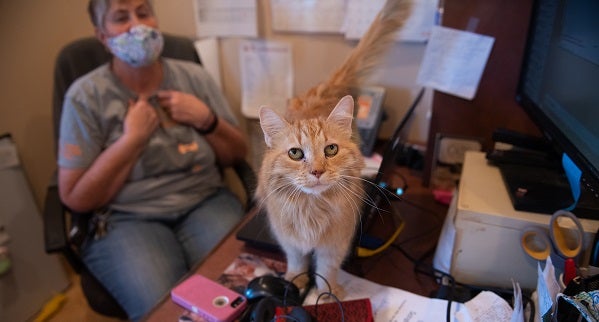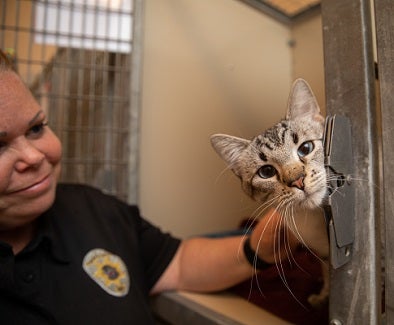
2022 national dataset shows mix of ups and downs
June 16, 2023
When Best Friends shared 2021’s national shelter data last year, it needed a bit of context. After all, that year’s data came on the heels of 2020’s unprecedented gains in lifesaving, which were inextricably linked to COVID’s surprisingly positive impact on both intake and outcomes. The data from 2021 was a course correction of sorts, a return to “normal” after an unusual year. This year’s dataset likewise needs a frame of reference. Although there are some results more in line with what we expect in year-over-year changes (minus COVID’s exception), there are some highs and lows to share from 2021 to 2022.
First, the dataset is a comprehensive look at the state of animal welfare today, making it a very helpful tool. It includes statistics from 85% of the nearly 4,000 brick-and-mortar shelters in the country and is representative of an estimated 95% of dogs and cats who entered shelters in 2022. Also on the positive side, the number of states, counties, and individual shelters reaching no-kill continues to climb. Such progress proves that programmatic and policy changes can deliver the kind of lifesaving we envision for the entire country.
On the not-as-great side, the dataset, unfortunately, confirms some of what we at Best Friends have been hearing anecdotally over the past year or more and what I witnessed first-hand in 2022 at Dallas Animal Services. There were roughly 4% more dogs entering shelters last year (a total of 91,000) with no increase in adoptions to off-set that figure. Subsequently, the overall canine save rate fell from 86.9% in 2021 to 82.7%.
The dataset holds a lot more information on either side of the ledger. Here are some of other takeaways:
Intake and save rates
 Overall intake was up to 4.4 million versus 4.3 million in 2021, with dogs making up almost the entire increase. Unlike the spike in dog intake, however, intake for cats has stayed steady year-over-year since 2019 at 2.1 million (down from 2.5 million pre-pandemic).
Overall intake was up to 4.4 million versus 4.3 million in 2021, with dogs making up almost the entire increase. Unlike the spike in dog intake, however, intake for cats has stayed steady year-over-year since 2019 at 2.1 million (down from 2.5 million pre-pandemic).
Shelters also maintained the 80% save rate for cats, a historic high first achieved in 2020. Overall, though, the national save rate fell from 83.5% in 2021 to 81.4% in 2022—another statistic that reflects the challenges organizations are having around finding positive outcomes for dogs (especially large dogs).
Adoptions/transfers
For the third straight year, cat adoptions have outpaced dog adoptions—which is good news for felines, whose intake numbers were essentially unchanged from 2021. Cat adoptions are holding steady at roughly 1.1 million, close to the number seen prior to the pandemic.
Unfortunately, the improvements in lifesaving for dogs seen in 2020 were not as sustainable. Adoptions have stalled at just under one million nationwide and have not returned to pre-pandemic levels. Last year also saw 15% fewer transfers out of shelters for all species—for dogs, that equals 6,137 per day, or 256 per hour.
Deaths
The total number of animals dying in shelters went up to 378,000, which is slightly more than 1,000 animals per day. Most were at municipal shelters, which saw a greater than 22% increase in the total number of animals (both dogs and cats) killed; private shelters showed a slight decrease, though most have the advantage of being limited admission (and were therefore less impacted by the rise in dog intakes). These were just a few of the factors that resulted in the national save rate dropping in 2022 for the first time since 2016.
The split is not 50/50 by species, however, as dogs once again had a much tougher year than cats. The increase in intake and the relatively low number of adoptions have resulted in nearly the same number of dogs dying in shelters in 2022 as in 2019, essentially erasing any early pandemic reductions in numbers killed. Conversely, fewer felines died in 2022 than 2021. For cats, organizations achieved an overall 51.9% reduction in killed since 2019.
No-kill shelters
The number of no-kill shelters across all states came in at an all-time high of 56.6%. The climbing number of no-kill shelters is good news, especially when you consider that only 24% of shelters were saving 90% or more in 2016 when Best Friends started collecting data for a national picture. The number of no-kill communities is up as well, coming in at 43% compared to 37% in 2021.

No-kill states
Vermont closed their small lifesaving gap of 89 animals and joined New Hampshire and Delaware as a no-kill state. North Dakota and Rhode Island have made progress closing their lifesaving gaps as well: North Dakota went from a gap of 41 to a gap of 37 last year, while Rhode Island dropped from 18 to 3. And with the trend showing that 92.5% of shelters maintain their no-kill status once they achieve it, we are optimistic about more states joining the ranks.
Other states with relatively small lifesaving gaps are Maine (121 dogs and cats) and Montana (152 animals). Florida, too, has made modest lifesaving progress overall, with 1,963 fewer deaths and 63% of state shelters reaching no-kill.
The list of the five states where most of the nation’s dogs and cats are being killed (54%) is the same as in 2021: Texas, California, North Carolina, Florida, and Georgia. Other than Florida seeing some progress, the remaining four had lifesaving setbacks in 2022. California had the highest increase in deaths (14,340) followed by Texas (7,700), North Carolina (2,058), and Georgia (1,529).
Identifying where help is needed
More than half (57%) of the increase in dogs and cats killed from 2021 to 2022 came from just 1% of shelters. These shelters are mostly large (intake of 5,000 or more) municipal or private with government contract organizations, and half are in either Texas or California. The purpose of gathering data is to better understand the challenges facing the nation and to come up with strategies that will help shelters accelerate lifesaving. Based on this new data set, Best Friends will continue to scale up programs like the Prince and Paws Shelter Collaborative Program. Named after the beloved adopted pets of the program’s lead investor and partner, the shelter collaborative program matches no-kill shelters (mentors) with those that are not yet no-kill (fellows). The shelters work together, with mentors teaching fellows how to save more lives.
Best Friends will also continue to focus on the embed program, which has roots dating back to 2011, when Best Friends piloted Community Cat Projects in partnership with PetSmart Charities®, that placed staff members in shelters to lead a game-changing program to dramatically increase cat save rates. Today, Best Friends is partnered with Maddie’s Fund®, and thanks to that partnership the national shelter embed program continues to place Best Friends staff members in agencies across the country. These staff members work side by side with agency staff to help them implement proven strategies about all aspects of sheltering to take their community to no-kill.
 In the words of my colleague Brent Toellner, senior director of lifesaving programs: "We want to help shelters achieve their lifesaving goals, and that involves identifying the assistance they need the most. Every aspect of our programmatic training and hands-on support—whether the focus is on big dogs or neonatal kittens, foster and adoption programs, efforts to engage the community, or the need to rework restrictive legislation—is designed to focus on maximizing their work’s greatest impact.”
In the words of my colleague Brent Toellner, senior director of lifesaving programs: "We want to help shelters achieve their lifesaving goals, and that involves identifying the assistance they need the most. Every aspect of our programmatic training and hands-on support—whether the focus is on big dogs or neonatal kittens, foster and adoption programs, efforts to engage the community, or the need to rework restrictive legislation—is designed to focus on maximizing their work’s greatest impact.”
To help shelters address these and many other growing challenges, the network is currently undergoing a strategic overhaul. In the coming months, network partners will begin to see increasingly targeted resources and expanded peer-to-peer co-solving opportunities, all powered by Shelter Pet Data Alliance (SPDA). SPDA is a data analytics platform powered by Best Friends in partnership with Maddie’s Fund, PetSmart Charities, and Petco Love that collects current data from approximately 7,400 shelters and rescues.
SPDA is helping drive a new wave of upcoming network offerings and is already guiding Best Friends staff and helping us to develop more impactful and tailored resources. Soon, it will allow organizations to create comparative monthly reports with other organizations, view national or regional trends, make predictions measuring positive impact over time. And network partners can schedule meetings with Best Friends data scientists to dig into their data, as well as gain a better understanding of what it is saying and how they can use it to continue improving operations.
The Best Friends Network is continuing to evolve with the goal of connecting partners not just to all the resources within Best Friends, but to the power of their peers. Chief Mission Officer Holly Sizemore put the power of the network best when she said:
“Early on, we recognized that no single organization could make no-kill 2025 happen alone. We built the concept of the network more than a decade ago around the philosophy that we can save them all if we work together. The network exists to give organizations the tools to save more animals, more efficiently, and partners have access to a wealth of professional resources and insight from our staff—from individuals working directly with animals, to the development team raising funds, to the experts who create playbooks about implementing new practices. Being a network partner can help new organizations start off strong and assist giant municipal shelters in overcoming longstanding hurdles.”
The pool of partner knowledge continues to grow with the total number of partners increasing by 567 to 4,251 last year. And network partners enjoy exclusive resources, including access to a wide variety of tools, unique funding opportunities, and support from specialized staff at Best Friends. A few of the most popular network perks include hands-on shelter assessments, national adoption events, executive and manager leadership courses, town halls, and an ever- growing library of toolkits, articles, and templates.
Despite the small dip in lifesaving in 2022, the industry shows a lot of forward momentum. Consider that, since 2016, three million more cats and dogs have been saved and the total number of pets killed per year has dropped by about 653,000. With 2025 only two years away, it’s more important than ever to anaylze animal sheltering data to maximize the impact of our shared efforts and resources. Looking intensely at this year’s data, especially in comparison to recent trends, gives us the information necessary to troubleshoot challenges big and small and pave the way to a nation where no animal is losing their life simply because they don’t have a home.
Click here to watch the roundtable of experts discussing data trends from 2020 to 2022 hosted by Best Friends.
Whitney Bollinger
Director of Strategy & Network Operations
Best Friends Network
If you enjoyed this editorial, you can find our complete catalog of editorials here.